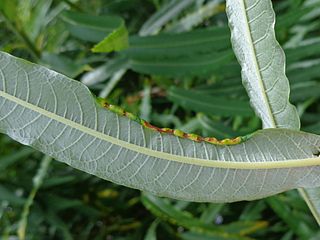
Rabdophaga rosaria is a gall midge which forms Camellia galls or terminal rosette gall on willow species. It was first described by Hermann Loew in 1850.
Rabdophaga clavifex is a gall midge which forms galls on the buds of willow species.
Rabdophaga strobilina is a gall midge and inquiline of Rabdophaga rosaria and Rabdophaga terminalis; also gall midges. It was first described by Johann Jacob Bremi-Wolf in 1847.
Rabdophaga strobilina is a gall midge which forms galls on the buds of some species of willow. It was first described by Hermann Loew in 1850.
Rabdophaga heterobia is a species of gall midges which has two generations a year and forms galls on almond willow. It was first described by Hermann Loew in 1850.

Rabdophaga rosariella is a species of gall midge which forms galls on sallows. It was first described by Jean-Jacques Kieffer in 1897.
Rabdophaga saliciperda is a species of gall midges which forms galls on willows. It was first described by Léon Jean Marie Dufour in 1841.

Rabdophaga salicis is a gall midge which forms galls on sallows. It was first described by Franz von Paula Schrank in 1803.
Rabdophaga degeerii is a gall midge which forms galls on the shoots of willows.
Rabdophaga albipennis is a gall midge which forms galls on the shoots of white willow.
Rabdophaga karschi is a gall midge which forms galls on the twigs of sallows.

Rabdophaga pierreana is a gall midge which forms galls on the young shoots of willow. It was first described by Jean-Jacques Kieffer in 1909.
Euura amerinae is a species of sawfly belonging to the family Tenthredinidae. The larvae form galls on bay willow. It was first described by Carl Linnaeus in 1758.

Euura atra is a species of sawfly belonging to the family Tenthredinidae. The larvae feed internally on the shoots of willows and do not usually form galls, although it is included in plant gall literature such as British Plant Galls. It was first described by Louis Jurine in 1807. E. atra is one of a number of closely related species known as the Euura atra subgroup.
Euura auritae is a species of sawfly belonging to the family Tenthredinidae. The larvae forms galls on willows. It was first described by Jens-Peter Kopelke in 2000. E. auritae is one of a number of closely related species which is known as the Euura atra subgroup.
Rabdophaga purpureaperda is a gall midge. The larvae tunnel in the shoots of purple willow and may cause the shoots to swell slightly. It was first described by Horace Francis Barnes in 1935.
Rabdophaga justini is a gall midge. It was first described by Horace Francis Barnes in 1935. The larvae tunnel in the shoots of purple willow.

Rabdophaga marginemtorquens is a gall midge which forms galls on willows and is found in Europe. It was described by Johann Jacob Bremi-Wolf in 1847.

Rabdophaga nervorum is a gall midge which forms galls on the leaves of sallows. It is found in Europe and was first described by the French entomologist, Jean-Jacques Kieffer in 1895.

Rabdophaga rigidae, the willow beaked-gall midge, is a species of gall midge in the family Cecidomyiidae. It is found across North America. Some sources state that it is also present in parts of eastern Asia including Japan; however, a 2006 study shows that the Asian populations likely represent a separate species: Rabdophaga salicivora.








